Trans. note: this refers to an actual intersection in Tehran named “Hijab.”
Merrifield, The Politics of the Encounter: Urban Theory and Protest under Planetary Urbanization (University of Georgia Press, 2013), 55–56.
Hanafi, “The Arab Revolutions: The Emergence of a New Political Subjectivity,” Contemporary Arab Affairs 5, no. 2 (2012): 203.
Trans. note: Green was the campaign color of the major reformist candidate Mir-Hossein Mousavi. He lost the dubious 2008 elections to Mahmoud Ahmadinejad, the major conservative candidate.
Trans. note: this is a distance covering over seventeen kilometers (about ten and a half miles), connecting two major squares in the city through a main avenue called Vali Asr.
Bayat, Life as Politics: How Ordinary People Change the Middle East (Amsterdam University Press, 2010). 44.
Borges, The Aleph and Other Stories, 1933–1969 (E. P. Dutton, 1970), 10–11.
Rosaldo, “Toward an Anthropology of Self and Feeling,” in Culture Theory: Essays on Mind, Self, and Emotion, ed. R. A. Shweder and R. A. LeVine (Cambridge University Press, 1984).
Trans. note: for more on this, see L, “Women Reflected in their Own History,” e-flux Notes, October 14, 2022 →.
Bayat, Revolution without Revolutionaries: Making Sense of the Arab Spring (Stanford University Press, 2017).
Translated from the Farsi by Roozbeh Seyedi. Translation edited by Soori Parsa.
